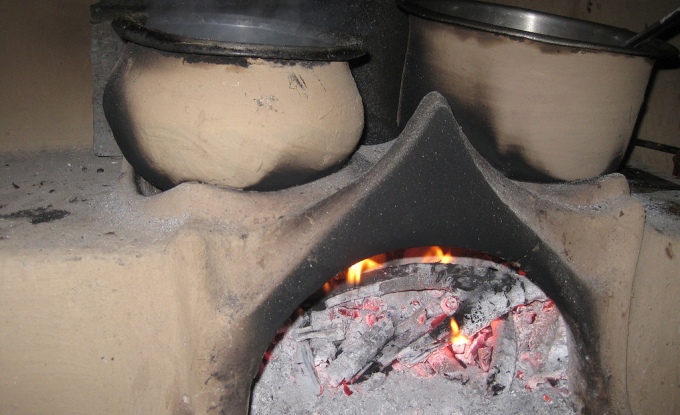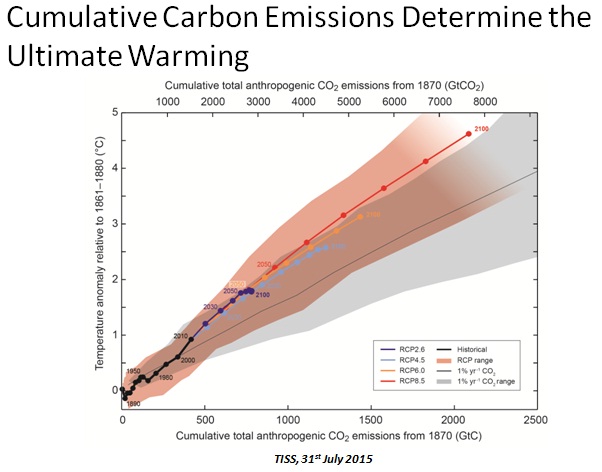Black carbon particles, a source of greenhouse gases, are of particular concern to South Asia where their emissions and radiative ‘perturbation’ are significantly higher and impact on climate and health of the people, say studies

Black carbon emitted by polluting sources like traditional chulhas has significant health and climate impacts, say studies. (Image by Shazoor Mirza)
Black carbon – airborne particles or aerosols which are released typically by burning biomass – is travelling much further from its sources in South Asia than originally thought. This has important implications for attempts to control this source of greenhouse gases (GHG), according to a new study by the US-based National Centre for Atmospheric Research (NCAR).
Scientists have become interested in black carbon (BC) emissions in recent years because they absorb the sun’s radiation and thereby affect the planet’s climate.
Among the most authoritative scholars of this phenomenon is Dr Veerbhadra Ramanathan of the Scripps Institution of Oceanography at San Diego in California.
Just prior to the UN’s World Summit on Sustainable Development in Johannesburg in 2002, the UN Environment Programme (UNEP) released a study which characterised these aerosols as creating the ‘Asian Brown Cloud’.
Indian officials and environmentalists had criticised these findings, questioning how sources such as burning farm waste and wood could cause such a regional phenomenon.
UNEP backed away from the controversy by renaming it the ‘Atmospheric Brown Cloud’, a descriptive that continues till today. However, most Indian experts now admit that it does exist and is a major cause for concern.
BC emissions vary according to the season and are lower during the monsoon, says the NCAR study, led by Dr Rajesh Kumar. They can affect atmospheric dynamics, the properties of clouds and freshwater resources.
It is emitted by industries, power plants, vehicles (particularly trucks using diesel), home cook stoves and by heating water, as well as by burning farm residue and forest fires.
However, the average life in the atmosphere is just a week, during which these particles can travel within the region and to neighbouring countries.
This makes it a “potential candidate for short-term global warming mitigation”, the study says, citing research by Dr Ramanathan and others.
BC particles have a special significance in South Asia, where their emissions and the associated radiative “perturbation” are significantly higher than elsewhere in the globe.
This is because South Asia, and the Indo-Gangetic plain in particular, is home to the largest number of poor people in the world, who don’t buy fossil fuels to cook or light their homes. In India alone, 300 million make do without electricity.
According to a report on access to clean cooking energy and electricity, released on September 29 by Columbia University and the Delhi-based Council on Energy, Environment & Water, “Once again, India tops the chart with close to 800 million continuing to use firewood, dung cakes, charcoal or crop residue to meet their cooking energy needs.”
Measurements show that BC emissions are the highest in winter, when wood fires are also lit to keep people warm and heat bathing water.
Earlier research, using models, found that BC can affect the monsoons, thereby imperilling major freshwater resources in South Asia.
In India, such research began nearly two decades ago. The Indian Ocean Experiment (INDOEX) revealed the significant presence of BC over the tropical Indian Ocean and highlighted the impacts it can have on regional climate and hydrology.
The first measurements of BC with a complete seasonal cycle were reported from a Thiruvananthapuram site in 2002. These measurement stations have grown rapidly since then, and year-round observations are available for 21 locations, rural and urban, in India.
The NCAR study was investigating the relative contributions of variations in regional meteorology as well as that of man-made biomass burning.
The highest manmade BC emissions occurred over the Indo-Gangetic plain, while the highest biomass burning emissions were found over Myanmar. The biggest emissions from biomass burning occurred between March and May.
Kumar and his co-authors find that the seasonality of BC is not determined by fluctuations in manmade emissions but by changes in South Asia’s meteorology. This happens through weakening of its horizontal movement in the atmosphere and strengthening of its vertical movement in summer as opposed to winter.
Thus, around a third of BC in peninsular India in winter emanates from the north Indian plains, while a similar proportion originating from south India in summer as well as the monsoons travels northwards.
While affecting the climate, BC also takes a toll of human health, say the authors. As much as 60% of BC is emitted by households.
Building on studies originally carried out a few decades ago in Gujarat villages by the American Dr Kirk Smith, the World Bank estimates that 150,000 people die prematurely in this country annually due to such indoor air pollution.
According to a 2012 Lancet study, India loses a million people every year due to indoor air pollution. A forthcoming article in the journal early next year, based on research by Johns Hopkins University, shows that a child born to a mother exposed to this pollution is 90 grammes lighter at birth.
“Before the NCAR study, we knew that BC travels from one part of India to the other but we did not much how much this cross-region transport contributes to BC pollution in different parts of India and we quantified that in this study,” Kumar told indiaclimatedialogue.net.
“We find that BC emitted from northern India contributes up to 30% to BC pollution in southern India during winter, while southern India makes a similar contribution to northern India’s BC pollution in the summer monsoon season.”
This result, he added, has important implications for BC mitigation strategies and means that the best approach to mitigating BC pollution is to form regional and national policies. For example, Bihar cannot mitigate its air pollution effectively without support of Uttar Pradesh and West Bengal.
“India’s Intended Nationally Determined Contributions (INDCs, commitments to the UN’s Paris climate summit) are aimed primarily at mitigation of greenhouse gases and not at particles like BC, but reduction in fossil fuel usage will help us in reducing the BC emissions too.
“The Indian government’s initiative to provide subsidized LPG to poor and generate electricity from solar plants will also help in reducing BC,” he said. Prime Minister Narendra Modi has recently spoken of providing LPG in small containers for the poor.
The NCAR study has been corroborated by a recent survey, led by Dr Harish Gadhavi from the National Atmospheric Research Laboratory (NARL), on BC emissions over in a single rural site, Gadanki, in Andhra Pradesh, where the laboratory is based.
His co-authors include a scientist from the Indian Institute of Tropical Meteorology in Pune and a scientist each from Austria and Norway.
They estimate that India alone contributes 7-14% of the region’s BC emissions, while such pollutants from outside the country account for only 5% of the country’s burden.
“We found that 93 to 95% of the model BC concentration is the result of emissions from India,” Gadhavi’s study says. “Northern India is a major source of anthropogenic (manmade) BC particles, but southern India also has significant BC emissions.”
“This study identifies a potentially significant underestimate of emissions in southern India, which is reflected in a large difference in the observed and modelled BC values in Gadanki during spring when the winds are predominantly from the south.”
In a 2010 study at the same site, Gadhavi found that the concentration of BC is found to be around 1,000 microgrammes per cubic metre (µg/m³) during the four monsoon months and around four times as much during pre- and post-monsoon months.
Dr K. Renuka of the NARL told indiaclimatedialogue.net that understanding seasonal variations of BC using models for India, on the lines of Dr Kumar and others corroborate the recent findings of Dr Gadhavi.
“Dr Gadhavi found that 5%-8% of BC observed at Gadanki is transported from outside India,” Renuka said. “Hence we can expect BC can be transported to much longer distances under favourable meteorological conditions. Since transportation is also contributing to observed BC concentrations (around 40%) at any given site, it is necessary that one should take care while making the policies on this.”
“Major sources of BC over India are from domestic and energy sectors. The use of natural energy sources like wind and solar will help in reducing the emissions from these sectors. Since burning bio-fuels and biomass are the main source of BC in rural regions, mitigating these emissions will improve the air quality in these regions.”
Though existing BC emissions over India are more than 1,000 gigatonnes a year (Gg/Yr), modelled BC values do not match the observations, she said. “This shows that some of the sources are underestimated in the inventories. There is need to develop accurate BC emission inventories to improve model estimations.”
Dr Krishna Achutha Rao of the Indian Institute of Technology in Delhi told the Tata Institute of Social Sciences at its climate conference this July that one of the reasons for the poor rainfall this year was the presence of BC in the atmosphere.
He told indiaclimatedialogue.net: “Rajesh Kumar’s study is a good contribution towards our continued quest for understanding BC and their behaviour; a good effort at modelling the space-time variation.”
“I’m personally a bit sceptical about reading too much into the conclusions because we really have a poor understanding of the sources.”
“The study basically tells us that the BC we emit in India slosh around with the weather affecting different parts of the country and little coming from outside. The health and climate effects of BC are ours to deal with.”
“India’s INDCs make no mention of BC and while that may look like a missed opportunity, the mitigation measures for BC are not straightforward enough for us to make commitments.”

